Blue city Morocco, nestled in the Rif Mountains, is home to Chefchaouen a surreal landscape that feels plucked from a dream. Walking through its narrow, winding streets is like stepping into an azure wonderland where buildings, doorways, steps, and even flowerpots are washed in captivating shades of blue. This enchanting blue city of Morocco has become one of North Africa most photogenic destinations, drawing travelers from around the globe seeking its unique charm and otherworldly aesthetic.
Beyond its Instagram-worthy facades, Chefchaouen offers visitors a deeply authentic Moroccan experience infused with its own distinct character. The medina quiet atmosphere, friendly locals, stunning mountain backdrop, and rich cultural tapestry create an ambiance unlike anywhere else in Morocco. Chefchaouen expertly balances its growing tourism with preserving the peaceful, artistic spirit that has defined it for centuries.
Whether you’re wandering through its blue-washed alleys, sipping mint tea in a plaza cafe, hiking in the surrounding mountains, or browsing handcrafted goods in its souks, Chefchaouen promises an unforgettable Moroccan experience that will linger in your memory long after you’ve departed its cobalt streets.
The Enigma of the Blue: Unraveling Chefchaouen Azure Hues
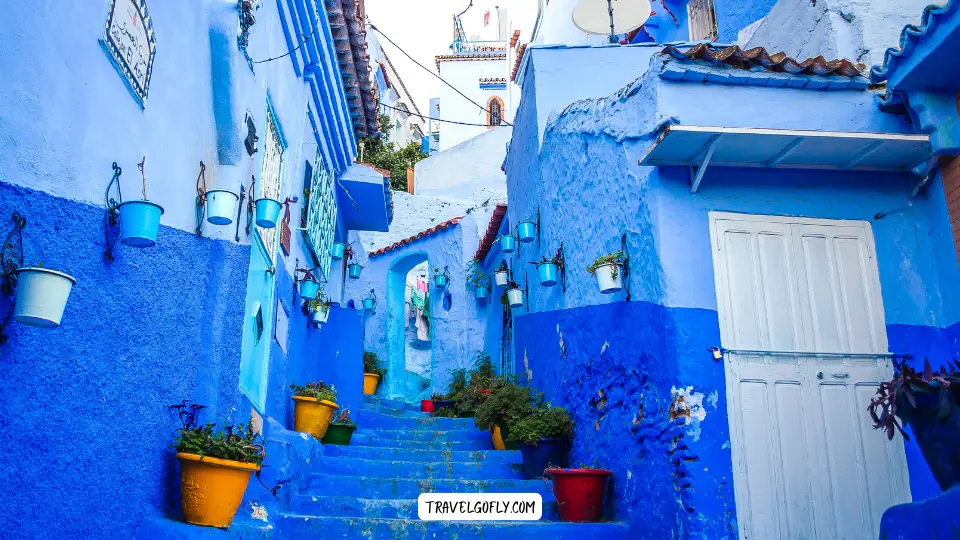 The striking blue hues that have made Chefchaouen famous worldwide are surrounded by several fascinating theories, each contributing to the mystique of this blue city in Morocco. While many travel blogs offer simplified explanations, the reality encompasses a rich tapestry of historical, cultural, and practical reasons.
The striking blue hues that have made Chefchaouen famous worldwide are surrounded by several fascinating theories, each contributing to the mystique of this blue city in Morocco. While many travel blogs offer simplified explanations, the reality encompasses a rich tapestry of historical, cultural, and practical reasons.
The Jewish Influence Theory
Perhaps the most widely cited explanation dates back to the 1930s when Jewish refugees fleeing Hitler Europe settled in Chefchaouen. They brought their tradition of painting buildings blue a color representing the sky and heaven in Judaism. According to Rabbi Eliyahu Avichail, a scholar of Jewish diaspora communities, “The blue in Jewish communities often represented divine protection and connection to spiritual realms.”
Historical records confirm a significant Jewish population in Chefchaouen during this period, many arriving from Tétouan and other parts of Morocco and Spain. While many eventually emigrated to Israel after 1948, their cultural influence remained imprinted on the city aesthetic.
The Mosquito Deterrent Theory
Local resident Mohammed Abdeslam explains: Our grandparents told us they mixed the blue paint with limestone, creating a solution that naturally repels mosquitoes. This practical explanation has scientific merit certain insects, including mosquitoes, are less attracted to blue surfaces. In a mountain town where water sources could breed insects, this adaptive measure made practical sense.
The Cooling Effect Explanation
The region scorching summer temperatures prompted creative solutions. “The blue color reflects sunlight rather than absorbing it, explains Hassan El Makhloufi, a local guide. Before air conditioning, this was our natural way to keep homes cooler during summer months. This temperature-regulating effect would have been particularly valuable in the medina tightly packed buildings.
Spiritual and Cultural Symbolism
For many locals, the blue represents water a precious resource in Morocco. “Water is life in our culture,” says Fatima Zahra, a lifelong resident. “The blue reminds us to value what sustains us.” Additionally, in Berber culture, blue has historically symbolized protection and safety.
The Modern Tourism Catalyst
What likely began as a combination of these factors has been amplified in recent decades. Local authorities recognized the distinctive appeal of the blue aesthetic and encouraged its expansion. “Yes, we maintain the blue because it is now our identity,” acknowledges Abdullah, who operates a small guesthouse. “It brings visitors who support our families.”
The truth likely lies in a convergence of these explanations, evolving organically over time. What began as a practical or cultural tradition has transformed into a defining characteristic that now shapes the city identity and economy. Regardless of its origins, the mesmerizing effect of Chefchaouen blue labyrinth continues to captivate all who visit the blue city of Morocco.
A Journey Through Time: The Rich History & Culture of Chefchaouen
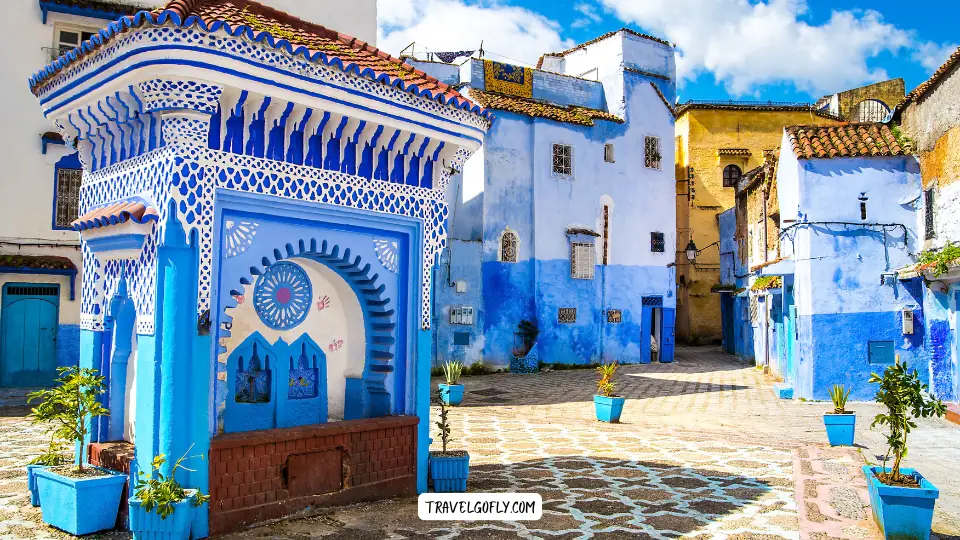 Timeline of Chefchaouen Development
Timeline of Chefchaouen Development
1471: Chefchaouen was founded by Moulay Ali Ben Rachid and Moorish exiles from Spain, establishing it as a fortress to fight Portuguese invasions of northern Morocco.
15th-16th Centuries: The city grew as more Andalusian Muslims and Jews fled the Spanish Reconquista, bringing their distinctive architectural styles and cultural practices.
1920-1956: Chefchaouen fell under Spanish protection during the colonial era, becoming part of Spanish Morocco. This period introduced European influences while intensifying local resistance to foreign control.
1956: Morocco gained independence, and Chefchaouen returned to Moroccan sovereignty.
1970s-1990s: The city became popular among travelers on the “hippie trail” gaining recognition for its relaxed atmosphere and reportedly, its cannabis cultivation in surrounding mountains.
2000s-Present: Chefchaouen transformed into a major tourism destination, particularly after social media showcased its photogenic blue streets to global audiences.
Cultural Mosaic: Influences That Shaped Chefchaouen
The blue city of Morocco represents a fascinating blend of cultures that have converged over centuries:
Andalusian Heritage: The influence of Spanish Muslims is evident in the city’s whitewashed buildings with blue trim, reminiscent of villages in southern Spain. The distinctive architecture features tiled roofs and inner courtyards unlike traditional Moroccan medinas.
Berber Traditions: The indigenous Amazigh (Berber) influence permeates local crafts, cuisine, and music. The weekly market still features Berber traders from surrounding Rif Mountain villages selling handwoven goods and agricultural products.
Jewish Legacy: Beyond potentially inspiring the blue color scheme, the Jewish community contributed to local commerce and crafts. Though small today, their historical presence is acknowledged in the preserved mellah (Jewish quarter).
Moroccan-Islamic Foundation: Five daily calls to prayer echo through the medina, and the city’s numerous mosques and religious schools reflect its deep Islamic roots. Traditional Islamic geometric patterns decorate many buildings and artifacts.
Rif Mountain Culture: The surrounding mountainous region has fostered a degree of isolation that preserved unique cultural elements. The local dialect blends Arabic with Berber and Spanish influences.
Living Traditions Unique to Chefchaouen
The blue city of Morocco maintains several distinctive cultural practices:
Textile Craftsmanship: Chefchaouen is renowned for its handwoven blankets and garments made from local wool, dyed using traditional methods and often featuring distinctive diamond patterns.
Culinary Specialties: Local dishes include goat tagine with seasonal vegetables and “bissara,” a distinctive fava bean soup topped with olive oil and cumin. The city is also known for its goat cheese production.
Spiritual Practices: Several zawiyas (Sufi religious houses) continue to operate in and around Chefchaouen, maintaining mystical Islamic traditions with weekly gatherings for chanting and prayer.
Festival of Tolerance: An annual celebration highlights the region’s history of coexistence between Muslim, Jewish, and Christian communities, featuring musical performances and cultural exchanges.
Traditional Hammams: Public bathhouses continue to serve as important social spaces where locals gather weekly, maintaining centuries-old bathing rituals.
This rich cultural tapestry makes Chefchaouen more than just a pretty blue backdrop—it’s a living museum where history continues to breathe through daily life in the narrow streets of this unique blue city of Morocco.
Planning Your Azure Adventure: The Essential Chefchaouen Toolkit
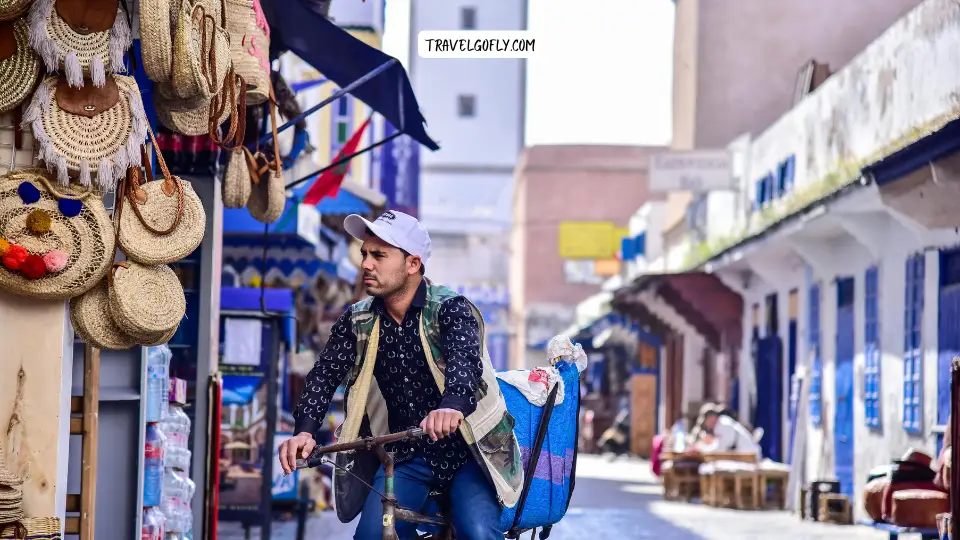 Best Time to Visit: A Month-by-Month Guide
Best Time to Visit: A Month-by-Month Guide
When planning your trip to the blue city of Morocco, timing can significantly impact your experience:
Spring (March-May): Perhaps the ideal season to visit Chefchaouen. Comfortable temperatures (65-75°F/18-24°C), blooming wildflowers in the surrounding mountains, and moderate tourism levels make this a perfect window. April brings the Cherry Festival in nearby villages.
Summer (June-August): Peak tourist season brings warmer temperatures (75-90°F/24-32°C) and larger crowds, especially in July and August when European visitors arrive. The city hosts several cultural festivals, including the popular Alegría Festival in July.
Fall (September-November): Another excellent time to visit with mild weather (60-75°F/16-24°C) and fewer tourists. The surrounding landscapes turn golden, and olive harvesting begins in late autumn, offering unique cultural experiences.
Winter (December-February): The quietest season with cooler temperatures (45-60°F/7-16°C) and occasional rain. January is typically the coldest month, with potential snow in the mountains. Accommodation prices drop significantly, though some businesses may operate on reduced hours.
Getting to the Blue City of Morocco: Comprehensive Transport Guide
International Access
Nearest Airports:
- Tangier Ibn Battouta Airport (TNG): 115km away (2-2.5 hour drive)
- Fès–Saïs Airport (FEZ): 200km away (4 hour drive)
- Rabat–Salé Airport (RBA): 250km away (4-5 hour drive)
From Tangier Airport to Chefchaouen:
- CTM/Supratours Bus: 70-90 MAD ($7-9), 3-3.5 hours including transfer to bus station
- Grand Taxi: 400-600 MAD ($40-60) for the entire taxi (can be shared with up to 6 people)
- Private Transfer: 800-1200 MAD ($80-120), bookable through hotels or online platforms
From Fès Airport to Chefchaouen:
- CTM Bus: 75-90 MAD ($7.5-9), requires getting to Fès bus station first
- Grand Taxi: 700-900 MAD ($70-90) for the entire vehicle
- Private Transfer: 1000-1500 MAD ($100-150)
From Major Moroccan Cities
From Marrakech: The longest route (approximately 550km)
- Bus: CTM or Supratours, 350-400 MAD ($35-40), 10-12 hours with a change in Casablanca or Rabat
- Train + Bus: Train to Tangier or Fès, then bus or taxi to Chefchaouen
- Private Transfer/Driver: 3000-4000 MAD ($300-400) for a direct journey
From Casablanca:
- Bus: CTM direct service, 150-200 MAD ($15-20), 5-6 hours
- Train + Bus: Train to Tangier, then bus to Chefchaouen
From Fès:
- CTM Bus: 75-90 MAD ($7.5-9), 4 hours, 3-4 departures daily
- Grand Taxi: From Bab Boujeloud area, 700-900 MAD ($70-90) per taxi
From Tangier:
- CTM/Supratours Bus: 70-90 MAD ($7-9), 2.5-3 hours, multiple departures daily
- Grand Taxi: From the main taxi station, 400-600 MAD ($40-60) per taxi
From Rabat:
- CTM Bus: 120-150 MAD ($12-15), 4-5 hours
- Train + Bus: Train to Tangier, then bus to Chefchaouen
Pro Tip: During peak season (July-August), book CTM/Supratours tickets at least 2-3 days in advance as routes to Chefchaouen sell out quickly.
Essential Travel Information
Visa & Entry Requirements
Morocco offers visa-free entry for many nationalities (including EU, UK, US, Canada, Australia) for stays up to 90 days. Your passport should be valid for at least six months beyond your entry date. Always check the latest requirements through your country foreign office or the Moroccan consulate.
Currency, Budgeting & Tipping
- Currency: Moroccan Dirham (MAD) – approximately 10 MAD = $1 USD
- Budget Guide:
- Budget traveler: 300-500 MAD ($30-50) per day
- Mid-range: 500-1000 MAD ($50-100) per day
- Luxury: 1000+ MAD ($100+) per day
- Tipping Culture: Typically 10% in restaurants, 10-20 MAD for hotel staff, 10% for guides
Essential Darija (Moroccan Arabic) Phrases
- “Salam” (Hello)
- “Shukran” (Thank you)
- “La shukran” (No thank you)
- “B’shhal?” (How much?)
- “Smehli” (Excuse me)
- “Mezyan” (Good/Nice)
- “Afak” (Please)
- “Fin kayn…?” (Where is…?)
- “La afham” (I don’t understand)
- “Mashi mushkil” (No problem)
Safety & Scams in Chefchaouen
The blue city of Morocco is generally very safe compared to larger Moroccan cities. Nevertheless:
- Avoid isolated areas after dark
- Watch for unofficial guides offering services
- Negotiate prices before accepting services
- Be wary of “special deals” or individuals offering to take you to “family shops”
- Keep valuables secure and be alert in crowded areas
What to Pack for Chefchaouen
- Comfortable walking shoes (essential for steep, cobblestone streets)
- Modest clothing (covering shoulders and knees for cultural sensitivity)
- Light layers (temperatures can vary significantly between day and night)
- Sun protection (hat, sunscreen, sunglasses)
- Light rain jacket (especially November-April)
- Camera with extra batteries/storage (you’ll take countless photos!)
- Small daypack for exploring
- Basic first aid items
Connectivity
- Most accommodations offer free WiFi, though speeds vary
- Moroccan SIM cards are inexpensive and widely available (INWI, Maroc Telecom, and Orange are major providers)
- Purchase SIM cards at the airport or official stores (avoid street vendors)
- A 10GB data package costs approximately 100 MAD ($10)
With these comprehensive planning details, you’ll be well-prepared to navigate your journey to Chefchaouen, the mesmerizing blue city of Morocco.
Where to Stay in Chefchaouen: From Charming Riads to Budget Gems
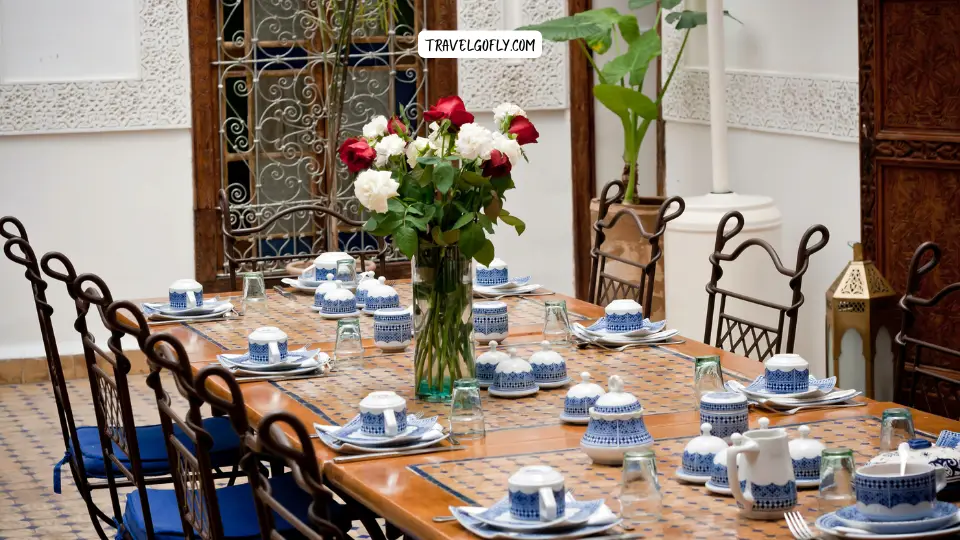 The accommodations in Chefchaouen reflect the unique character of this blue city in Morocco, with options ranging from authentic riads to modern boutique hotels. Here’s a curated selection across different budget categories:
The accommodations in Chefchaouen reflect the unique character of this blue city in Morocco, with options ranging from authentic riads to modern boutique hotels. Here’s a curated selection across different budget categories:
Luxury & Boutique Accommodations
Lina Ryad & Spa ⭐⭐⭐⭐⭐
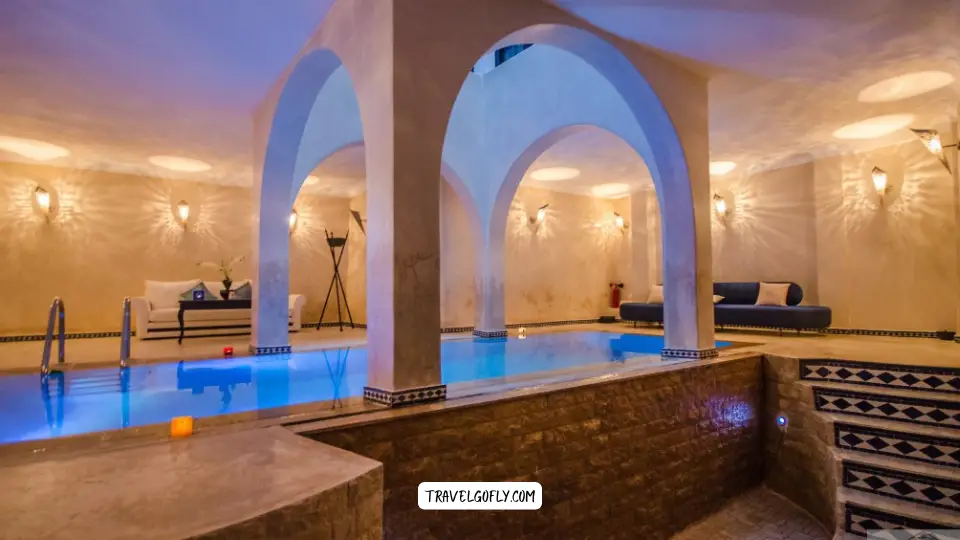
Best for Authentic Luxury This stunning property offers panoramic views of the Rif Mountains from its rooftop terrace. The traditional Andalusian architecture blends seamlessly with modern amenities, including a hammam spa and elegant rooms featuring handcrafted furniture. Expect to pay 1,200-2,000 MAD ($120-200) per night.
Casa Hassan ⭐⭐⭐⭐
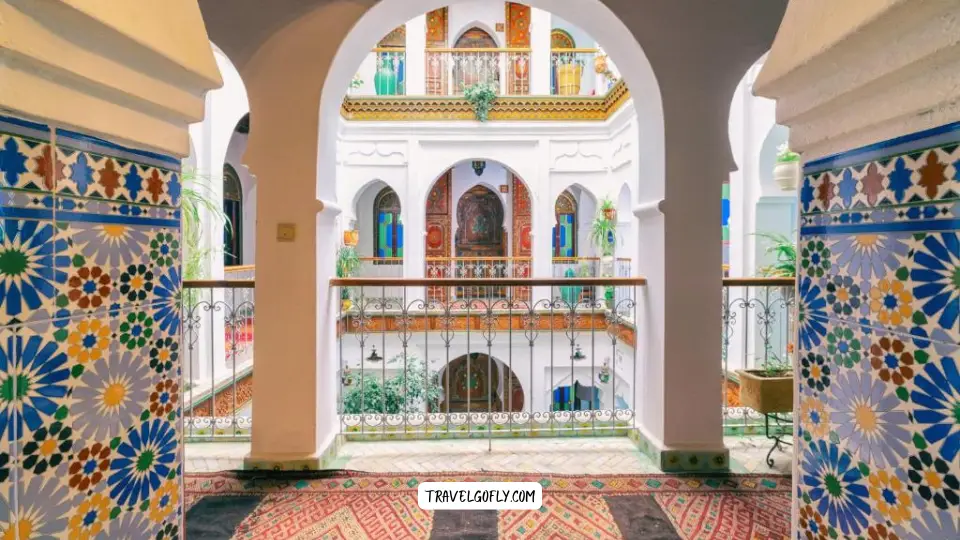 Best for Cultural Immersion A beautifully restored traditional home in the heart of the medina, Casa Hassan showcases stunning Moroccan craftsmanship with its mosaic tilework, carved wooden ceilings, and authentic furnishings. Their on-site restaurant serves excellent traditional cuisine. Rates range from 900-1,500 MAD ($90-150) per night.
Best for Cultural Immersion A beautifully restored traditional home in the heart of the medina, Casa Hassan showcases stunning Moroccan craftsmanship with its mosaic tilework, carved wooden ceilings, and authentic furnishings. Their on-site restaurant serves excellent traditional cuisine. Rates range from 900-1,500 MAD ($90-150) per night.
Dar Echchaouen ⭐⭐⭐⭐
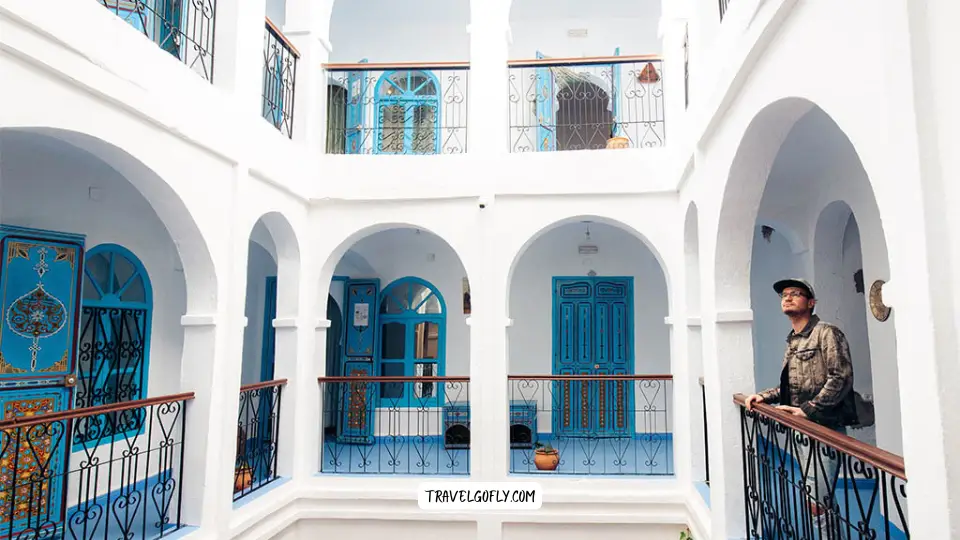
Best for Views Located at the edge of the medina with unparalleled panoramic views of both the blue city and mountains, this riad features a swimming pool and terraced gardens. Rooms combine traditional Moroccan elements with comfortable modern touches. Room rates: 800-1,400 MAD ($80-140).
Mid-Range Options
Dar Zambra ⭐⭐⭐
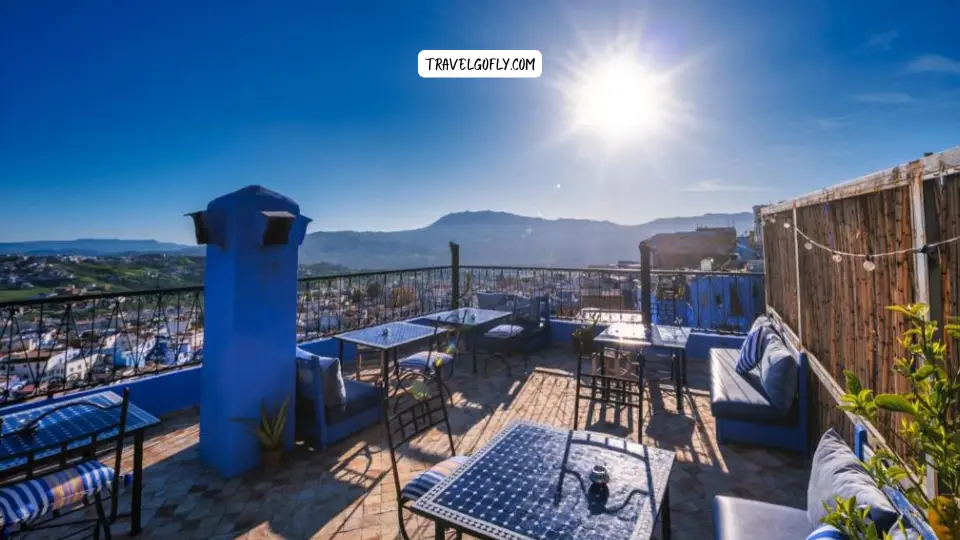 Best Value This charming guesthouse offers beautifully decorated rooms centered around a traditional courtyard. The rooftop terrace provides stunning views, and the hospitable owners create a welcoming atmosphere. Rates: 500-800 MAD ($50-80).
Best Value This charming guesthouse offers beautifully decorated rooms centered around a traditional courtyard. The rooftop terrace provides stunning views, and the hospitable owners create a welcoming atmosphere. Rates: 500-800 MAD ($50-80).
Hotel Parador ⭐⭐⭐
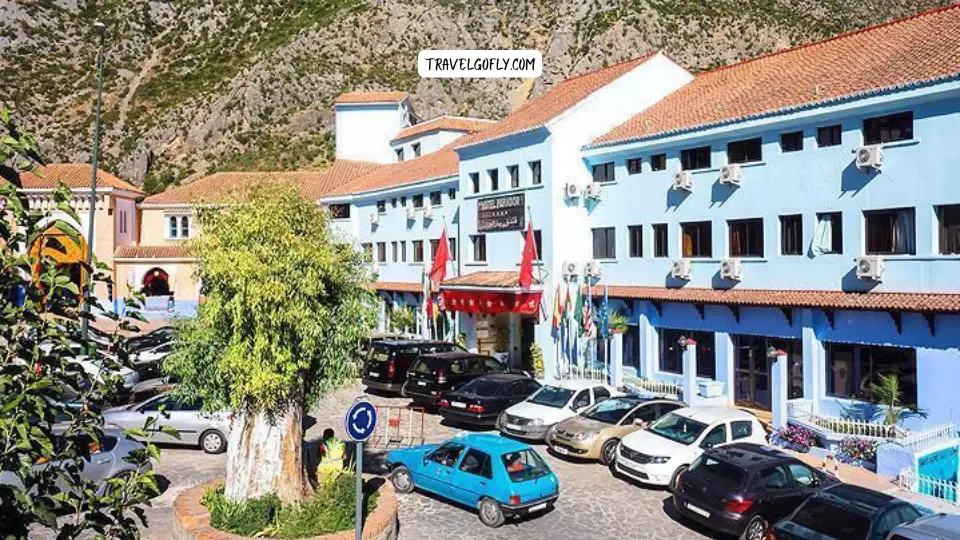 Best for Convenience Situated near Plaza Uta el-Hammam, this hotel combines a prime location with comfortable rooms and excellent service. The building features traditional architecture with modern comforts. Prices range from 600-900 MAD ($60-90).
Best for Convenience Situated near Plaza Uta el-Hammam, this hotel combines a prime location with comfortable rooms and excellent service. The building features traditional architecture with modern comforts. Prices range from 600-900 MAD ($60-90).
Riad Hicham ⭐⭐⭐
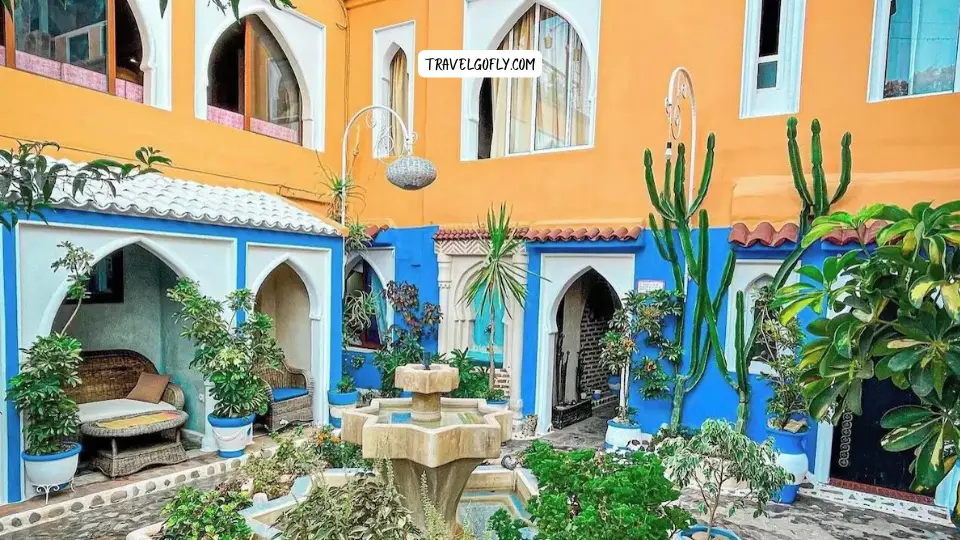
Best for Families Offering spacious family rooms and suites, this riad provides a peaceful retreat with a central courtyard and fountain. The helpful staff can arrange activities throughout Chefchaouen. Expect to pay 500-700 MAD ($50-70).
Budget-Friendly Accommodations
Dar Terrae ⭐⭐
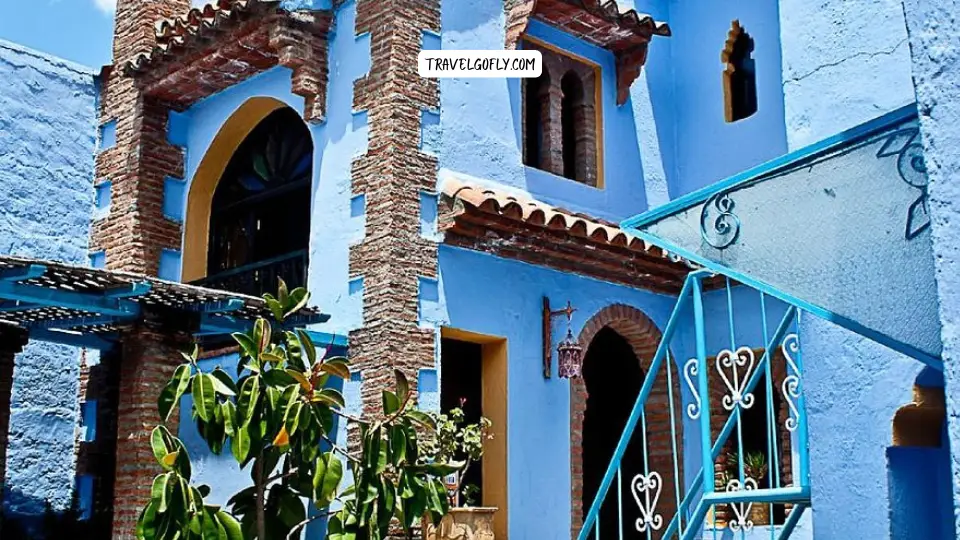 Best Budget Experience This charming guesthouse offers clean, simple rooms with traditional décor at very reasonable prices. The communal terrace provides impressive views, and the friendly owner shares valuable local insights. Rates: 250-400 MAD ($25-40).
Best Budget Experience This charming guesthouse offers clean, simple rooms with traditional décor at very reasonable prices. The communal terrace provides impressive views, and the friendly owner shares valuable local insights. Rates: 250-400 MAD ($25-40).
Hotel Souika ⭐⭐
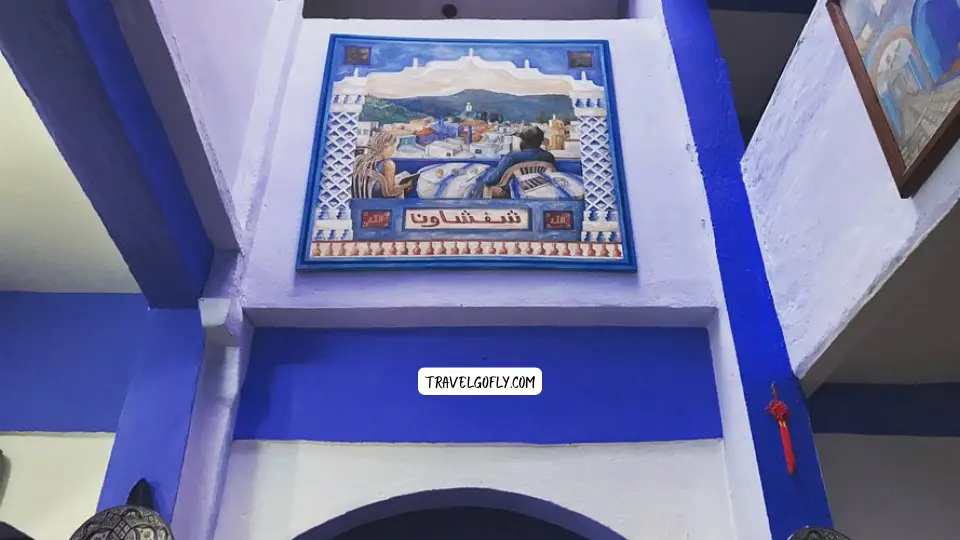 Best Central Budget Option Located in the heart of the medina, this basic but clean hotel offers excellent value. Some rooms have small balconies overlooking the blue streets below. Prices range from 200-350 MAD ($20-35).
Best Central Budget Option Located in the heart of the medina, this basic but clean hotel offers excellent value. Some rooms have small balconies overlooking the blue streets below. Prices range from 200-350 MAD ($20-35).
Auberge Dardara ⭐⭐
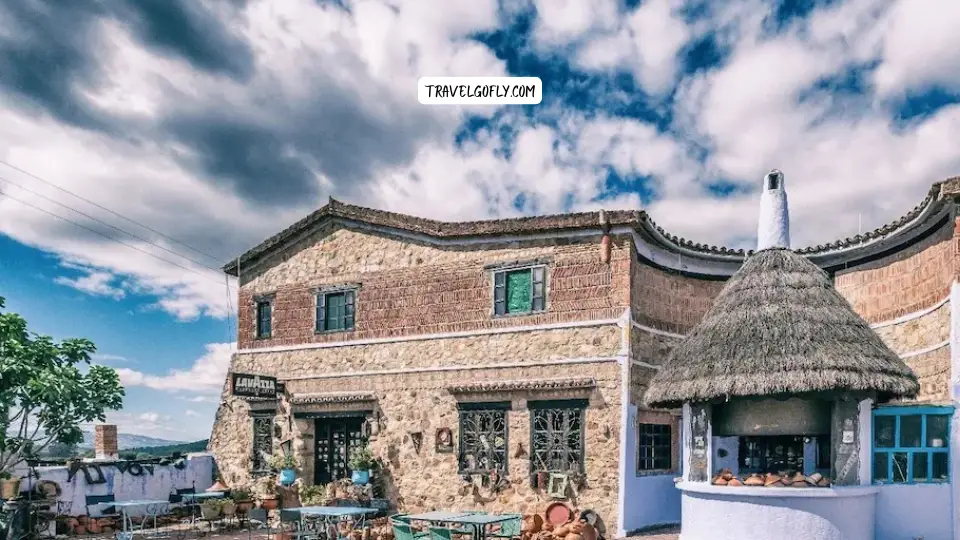 Best Rural Experience Located just outside Chefchaouen, this farmhouse-style accommodation offers a unique countryside experience with easy access to the blue city. Their restaurant serves farm-to-table Moroccan cuisine. Rates: 300-450 MAD ($30-45).
Best Rural Experience Located just outside Chefchaouen, this farmhouse-style accommodation offers a unique countryside experience with easy access to the blue city. Their restaurant serves farm-to-table Moroccan cuisine. Rates: 300-450 MAD ($30-45).
Tips for Booking Accommodations in Chefchaouen
- Reserve well in advance: Despite its growing number of accommodations, the blue city of Morocco gets fully booked during peak seasons (April-May and September-October).
- Consider location carefully: Staying within the medina means atmospheric surroundings but potentially difficult access with luggage (many riads are only accessible by foot up steep, narrow streets).
- Verify amenities: Many traditional riads may lack facilities like elevators, air conditioning, or heating. During summer and winter, these can be important considerations.
- Check for terrace access: A rooftop terrace with views over the blue city is one of the highlights of staying in Chefchaouen.
- Communicate arrival details: If staying in the medina, arrange in advance for someone to meet you at an accessible drop-off point to guide you to your accommodation.
- Understand riad layouts: Traditional riads are built around central courtyards, which means some rooms may lack external windows or privacy from common areas.
- Consider half-board options: Many riads offer excellent home-cooked Moroccan meals that provide authentic dining experiences at reasonable prices.
Whether you choose a luxury riad or a simple guesthouse, staying within the blue streets of Chefchaouen offers an immersive experience in this unique blue city of Morocco that can’t be replicated elsewhere.
The Unmissable Top 15+ Things to Do & See in Chefchaouen
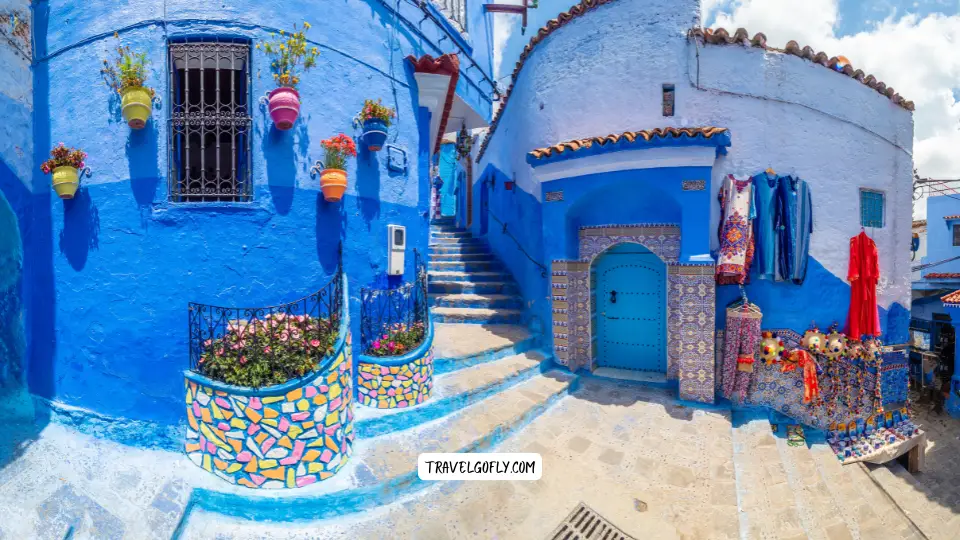 Exploring the blue city of Morocco is a feast for the senses. Here’s your definitive guide to the most remarkable experiences in Chefchaouen:
Exploring the blue city of Morocco is a feast for the senses. Here’s your definitive guide to the most remarkable experiences in Chefchaouen:
1. Wander the Blue Medina (But With Purpose!)
While “getting lost in the blue streets” is standard advice, approach this experience with more intention. The most photogenic blue alleys are located in the northeast section of the medina, particularly around Rue Suika and Rue El Kharrazin. These streets feature the most vibrant blue buildings and charming details like blue flowerpots and artistic doorways.
Best Time: Early morning (7-9 AM) before crowds emerge or late afternoon when the golden light enhances the blue hues.
Local Insight: The blues appear different throughout the day, shares Mohammed, a local artist. “Morning light brings out the softer pastel blues, while afternoon sun illuminates the more vibrant indigos.”
2. Plaza Uta el-Hammam: The Heart of Chefchaouen
This main square serves as the social hub of the blue city. Surrounded by restaurants, shops, and the Kasbah, it’s where locals and visitors alike gather. The plaza is lined with cafes where you can enjoy Moroccan mint tea while people-watching.
Don’t Miss: The 18th-century Grand Mosque on the eastern side (non-Muslims cannot enter but can admire its unique octagonal minaret from outside).
3. Explore the Kasbah Museum
The restored 15th-century fortress houses an ethnographic museum showcasing the region’s rich history. The Kasbah’s gardens and former prison provide fascinating glimpses into Chefchaouen’s past.
Admission: 60 MAD ($6) Hours: 9 AM-6 PM (closed Tuesdays) Highlight: Climb the tower for panoramic views of the blue city of Morocco below.
4. Chase Waterfalls at Ras El Ma
On the eastern edge of the medina, this small waterfall is where local women traditionally wash clothes. Follow the stream uphill along a pleasant walking path for increasingly dramatic views of the water against the backdrop of mountains.
Best Time: Morning or late afternoon when local activities are in full swing Tip: Continue walking about 20 minutes up the path for a more serene experience away from other visitors.
5. Hike to the Spanish Mosque for Sunset
This abandoned mosque sits on a hillside overlooking Chefchaouen, offering the most spectacular views of the blue city of Morocco.
The Hike: A moderate 30-45 minute walk following a clear path from the eastern gate of the medina Best Time: Arrive 30-45 minutes before sunset to secure a good spot Bring: Water, camera, light jacket (it can get breezy), and a small picnic if desired
6. Visit a Traditional Bakery
Seek out one of the community ovens where locals bring their homemade bread dough to be baked.
Where: Follow the aroma down Rue Hassan I or ask locals to direct you to the nearest “ferran” (communal oven) Experience: For a few dirhams, you can try freshly baked khobz (Moroccan bread) straight from the oven
7. Experience a Traditional Hammam
For an authentic Moroccan experience, visit a local bathhouse. The Hammam Tradition offers a genuine experience with separate hours for men and women.
Cost: 50-100 MAD ($5-10) for entrance, plus extra for scrubbing service (gommage) Bring: Towel, flip-flops, change of clothes (or rent these items onsite) Cultural Note: This is an important social ritual for locals—observe proper etiquette by following others’ lead.
8. Shop for Authentic Handicrafts
Chefchaouen is renowned for its handwoven blankets, rugs, and clothing items made from local wool.
Best Shopping Areas: Rue Suika and the streets surrounding Plaza Uta el-Hammam Must-Buy Items: Handwoven blankets with distinctive diamond patterns, leather goods, and locally-made goat cheese Shopping Tip: Prices are generally lower than in Marrakech or Fes, but haggling is still expected (start at 40-50% of the initial asking price).
9. Take a Weaving Workshop
Several local cooperatives offer short workshops where you can learn traditional weaving techniques.
Recommended: Women’s Cooperative near Bab Souk Duration: 1-3 hours Cost: 150-300 MAD ($15-30) including materials
10. Enjoy Panoramic Views from Hotel Atlas
Even if you’re not staying here, visit their rooftop cafe for exceptional views across the blue medina.
Access: Purchase a drink at the cafe (30-50 MAD) Best Time: Late afternoon for golden light on the blue buildings
11. Taste Local Cuisine at Restaurant Beldi Bab Ssour
This authentic restaurant serves traditional Rif Mountain specialties including goat tagine and bissara.
Location: Near Bab Ssour gate Price Range: 70-120 MAD ($7-12) for main dishes Must-Try: Their slow-cooked tagine with local seasonal vegetables
12. Visit the Ethnographic Museum
Smaller than the Kasbah but offering focused exhibits on local Berber culture and traditional lifestyles.
Admission: 20 MAD ($2) Hours: 9 AM-6 PM Highlight: Beautiful collection of traditional regional costumes and jewelry
13. Discover Ras El Maa Waterfall
Where the city meets nature, this small waterfall marks the boundary between urban and rural landscapes.
Location: Eastern edge of the medina Activity: Follow the path alongside the stream to see how water remains integral to daily life
14. Take a Pottery Class at Art Tisane
Learn traditional pottery techniques using local clay.
Duration: 2-3 hours Cost: 200-300 MAD ($20-30) Booking: Arrange at least one day in advance through your accommodation
15. Explore the Jewish Quarter (Mellah)
Discover traces of the city’s multicultural past in this historic neighborhood.
Highlight: The restored synagogue and distinctive architecture showing the blend of cultures
16. Attend a Traditional Music Performance
Several cafes host evening performances of Andalusian and Berber music.
Recommended Venue: Café Restaurant Aladin Schedule: Usually begins around 8 PM on weekends Cost: Price of a meal or drink (100-150 MAD)
Iconic Photo Spots in the Blue City of Morocco
The Blue Staircase: Located near Pension Souika, this picturesque stairway lined with flowerpots is one of the most photographed spots in Chefchaouen. Best Light: Mid-morning when sun illuminates the steps
Callejon El Asri: This narrow blue passage features a stunning archway and vibrant walls. Best Time: Early morning before crowds arrive
Rooftop View from Lina Ryad: One of the highest accessible terraces in the medina. Access: Free for guests, or purchase a drink at their rooftop cafe
Corner of Rue Targui and Rue Sidi Ahmed el Uafi: Where two blue alleys meet with colorful plant pots creating perfect framing. Photography Tip: Use a wide-angle lens to capture the converging blue walls
Blue Door Collection: The area around Rue El Kharrazin features numerous ornate doors in varying shades of blue against blue walls. Best Approach: Create a photo series of different door styles and details
From spiritual sites to culinary adventures, the blue city of Morocco offers experiences that engage all your senses while providing countless opportunities to create stunning photographs of its unique azure landscape.
Beyond the Blue Walls: Day Trips & Hiking in the Rif Mountains
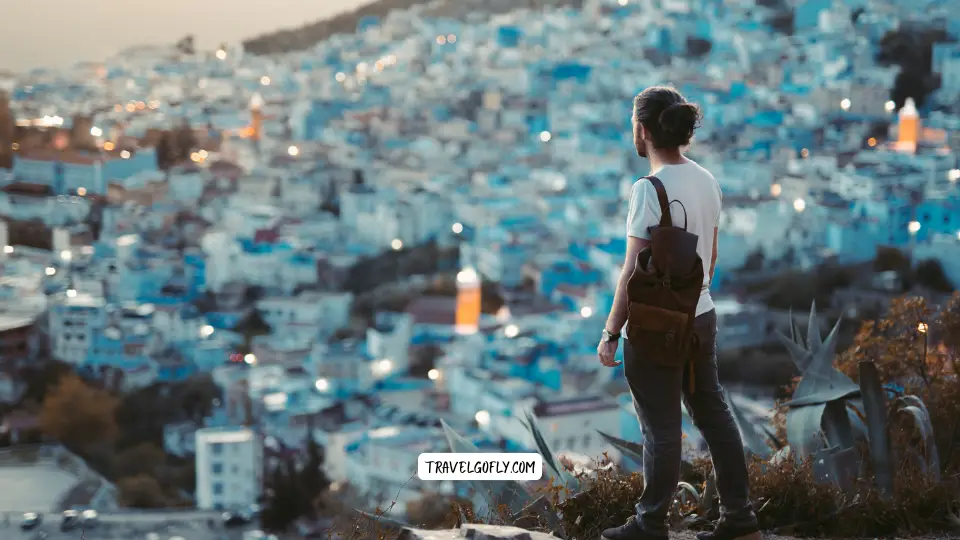 While Chefchaouen blue medina captivates visitors, the surrounding Rif Mountains offer equally remarkable experiences. The dramatic landscapes surrounding the blue city of Morocco provide opportunities for adventure, nature appreciation, and deeper cultural insights.
While Chefchaouen blue medina captivates visitors, the surrounding Rif Mountains offer equally remarkable experiences. The dramatic landscapes surrounding the blue city of Morocco provide opportunities for adventure, nature appreciation, and deeper cultural insights.
Akchour Waterfalls & God Bridge: A Natural Paradise
Just 30km from Chefchaouen lies Akchour, home to stunning waterfalls and natural rock formations within Talassemtane National Park.
Getting There:
- Shared Grand Taxi: 25-30 MAD ($2.50-3) per person from Chefchaouen’s taxi stand, 30-minute drive
- Private Taxi: 150-200 MAD ($15-20) round trip with waiting time
- Guided Tour: 350-500 MAD ($35-50) including transportation and guide
Hiking Options:
1. Small Waterfall Trail (Petite Cascade)
- Difficulty: Easy to moderate
- Distance: 3.5km round trip (approximately 1.5-2 hours)
- Highlights: Refreshing swimming opportunities in crystal clear pools
2. God’s Bridge (Pont de Dieu)
- Difficulty: Moderate
- Distance: 8km round trip (3-4 hours)
- Highlights: Impressive natural rock arch spanning the river
3. Large Waterfall Trail (Grande Cascade)
- Difficulty: Moderate to challenging
- Distance: 12km round trip (5-6 hours)
- Highlights: Spectacular 100m cascading waterfall
Essential Tips for Akchour:
- Timing: Start early (before 9 AM) to avoid crowds, especially on weekends
- What to Bring: Sturdy shoes, sun protection, swimwear (for summer), at least 1.5 liters of water per person, snacks
- Facilities: Simple cafes serving grilled fish and tagines line the trail near the river
- Costs: 10 MAD ($1) park entrance fee
Local Insight: “Visit on a weekday if possible,” advises Ibrahim, a local guide. “The trails become quite busy with domestic tourists on weekends, especially during summer months.”
Talassemtane National Park: A Biodiversity Hotspot
This 60,000-hectare protected area surrounding Chefchaouen is part of a UNESCO Biosphere Reserve with remarkable biodiversity, including rare Barbary macaques and over 30 endemic plant species.
Recommended Hiking Routes:
1. Fir Forest Trail
- Difficulty: Moderate
- Duration: 4-5 hours
- Starting Point: Talassemtane Visitor Center
- Highlights: Ancient Spanish fir trees found nowhere else in Africa
2. Ridge Hike to Jebel el Kelaa
- Difficulty: Challenging
- Duration: Full day (7-8 hours)
- Starting Point: Village of Mechkralla
- Highlights: Panoramic views of the Mediterranean and the Rif range
- Guide: Required and can be arranged through hotels in Chefchaouen (350-500 MAD/$35-50)
Important Considerations:
- Guides are highly recommended for all but the shortest trails due to limited trail markings
- The park contains sensitive ecological zones; respect all guidelines and practice Leave No Trace principles
- Some areas require permits—check with the visitor center before setting out
Exploring Nearby Villages
Several traditional Berber villages around Chefchaouen offer glimpses into rural Moroccan life largely unchanged by tourism.
Oued Laou (40km north)
- Quiet fishing village with beautiful beaches
- Getting There: Grand taxi from Chefchaouen (30-40 MAD/$3-4 per person)
- Highlights: Seafood restaurants serving fresh catches, pristine Mediterranean beaches
Bab Taza (30km south)
- Traditional agricultural village known for olive oil production
- Getting There: Hourly shared taxis (15-20 MAD/$1.5-2)
- Highlights: Thursday weekly market with local produce and crafts
Tamorot (15km east)
- Remote mountain village with spectacular views
- Getting There: Requires hiring a private taxi (150-200 MAD/$15-20 round trip)
- Highlights: Traditional architecture, weaving cooperatives, hiking trails
Multi-Day Trekking Options
For serious hikers, the region offers multi-day treks connecting mountain villages:
The Rif Trail: A 3-5 day trek through traditional villages and diverse landscapes
- Difficulty: Challenging
- Accommodation: Basic guesthouses in villages or camping
- Guide: Essential (600-800 MAD/$60-80 per day including food)
- Best Season: April-May or September-October
“The mountains around Chefchaouen hold stories and traditions as beautiful as the blue city itself,” explains Mohammed, who leads cultural treks. “Visitors who take time to explore beyond the blue walls often find these experiences become the highlight of their journey.”
Whether you’re seeking adventure, tranquility, or cultural immersion, the landscapes surrounding the blue city of Morocco offer rich experiences that complement your time in Chefchaouen’s mesmerizing medina.
A Taste of Chefchaouen: What & Where to Eat & Drink
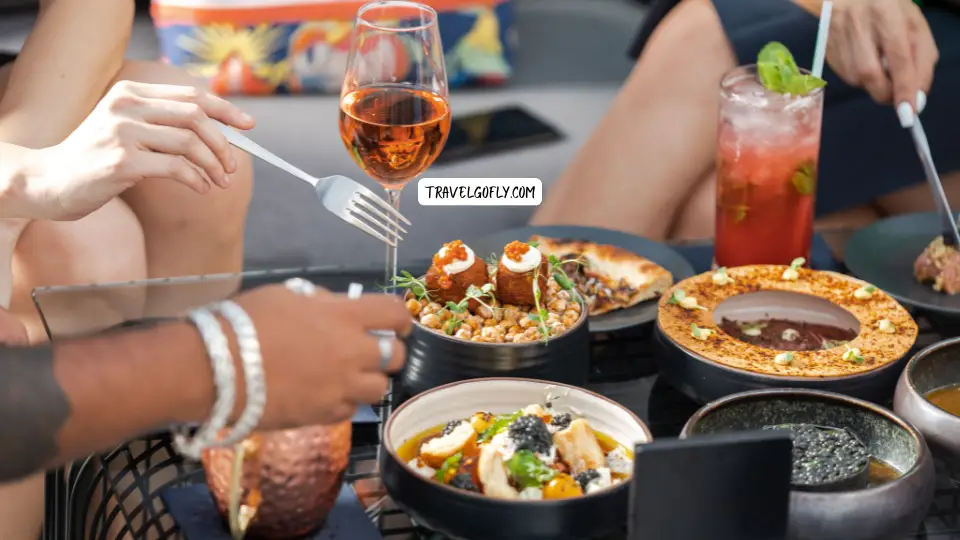 The culinary landscape of Chefchaouen reflects its unique geographical and cultural position. Here in the blue city of Morocco, traditional Moroccan dishes merge with Mediterranean influences and local Rif Mountain specialties to create a distinctive food scene worth exploring.
The culinary landscape of Chefchaouen reflects its unique geographical and cultural position. Here in the blue city of Morocco, traditional Moroccan dishes merge with Mediterranean influences and local Rif Mountain specialties to create a distinctive food scene worth exploring.
Must-Try Local Dishes
Tagine with Goat Meat: While tagines are found throughout Morocco, Chefchaouen version often features locally raised goat flavored with regional herbs from the Rif Mountains.
Bissara: This hearty fava bean soup topped with olive oil, cumin, and paprika makes for a perfect breakfast or light lunch. It’s typically served with fresh khobz (Moroccan bread) for dipping.
Jben: Chefchaouen is famous for this fresh, soft goat cheese sold in local markets, often wrapped in palm leaves. Enjoy it drizzled with local olive oil and herbs.
Kalinti: A chickpea flour-based dish similar to a savory flan, influenced by Spanish cuisine and often enjoyed as street food.
Mint Tea: More than just a beverage, the preparation and serving of mint tea is a cherished ritual in the blue city of Morocco. Look for versions incorporating local herbs like sage, wormwood, or wild thyme.
Where to Eat in Chefchaouen
Best Traditional Restaurants
Restaurant Beldi Bab Ssour Located near Bab Ssour gate This locally-owned establishment offers authentic home-style cooking with dishes prepared in traditional clay tagines. Their slow-cooked lamb with prunes and almonds receives consistent praise. Price Range: 70-150 MAD ($7-15) per person Specialties: Goat tagine, chicken with preserved lemons and olives
Restaurant Populaire Bab Ssour Off Plaza Uta el-Hammam A no-frills eatery where locals gather for hearty, affordable meals. The menu changes daily based on seasonal ingredients. Price Range: 50-80 MAD ($5-8) per person Specialties: Bissara, kefta tagine
Lala Mesouda Rue Targui Set in a traditional Moroccan home with a beautiful courtyard, this restaurant offers a more refined dining experience with family recipes passed down through generations. Price Range: 120-200 MAD ($12-20) per person Specialties: Pastilla (savory-sweet pastry), vegetable couscous
Best Restaurants with Views
Café Restaurant Belmundo Near Plaza Uta el-Hammam This terrace restaurant offers panoramic views of the blue city and mountains beyond. The menu combines Moroccan classics with Mediterranean influences. Price Range: 80-150 MAD ($8-15) per person Specialties: Fish tagine, Mediterranean salads
Restaurant Aladdin Plaza Uta el-Hammam Prime location on the main square with upper-level seating overlooking the Kasbah. Popular for both Moroccan classics and international options. Price Range: 100-180 MAD ($10-18) per person Specialties: Seafood pastilla, lamb couscous
Best Budget Eateries
Café Clock Derb Sidi Ali Berrak A cultural hub as well as an eatery, offering affordable fusion dishes including their famous camel burger alongside traditional options. Price Range: 50-90 MAD ($5-9) per person Specialties: Camel burger, breakfast platters, date milkshakes
Sofia’s Snack Rue Hassan I Popular with both locals and budget travelers for quick, tasty meals and fresh juices. Price Range: 30-60 MAD ($3-6) per person Specialties: Moroccan sandwiches, fresh fruit smoothies
Best Cafés
Café Hafa Near the waterfall This terraced café offers stunning views of the surrounding landscape. Simple menu focused on drinks and light snacks. Price Range: 10-30 MAD ($1-3) per drink Specialties: Mint tea, almond cookies
Café La Lampe Magique Plaza Uta el-Hammam Multi-level café with rooftop seating overlooking the main square. Perfect for people-watching and sunset views. Price Range: 15-40 MAD ($1.5-4) per drink Specialties: Specialty coffees, fresh orange juice, pastries
Tips for Dining in Chefchaouen
- Meal Timing: Lunch is typically served from 12-3 PM and dinner from 7-10 PM. Some establishments close in the afternoon.
- Street Food Safety: For the freshest street food, patronize stands with high turnover and where you can see the food being prepared.
- Water Considerations: Stick to bottled water, which is inexpensive and widely available.
- Breakfast Culture: Many riads include traditional Moroccan breakfasts featuring fresh bread, olive oil, honey, jams, and eggs. It’s worth experiencing at least once during your stay in the blue city of Morocco.
- Ramadan Awareness: If visiting during Ramadan, restaurant hours may be limited during daylight hours, with most places opening for Iftar (breaking of fast) after sunset.
- Tipping Etiquette: 10% is standard in restaurants, though not strictly required in very casual establishments.
- Alcohol Availability: As a conservative area, alcohol is limited in Chefchaouen. A few upscale restaurants and hotels serve it, but don’t expect to find it widely available.
The culinary experiences in Chefchaouen provide not just nourishment but insight into the region’s cultural heritage, agricultural traditions, and the daily rhythms of life in this enchanting blue city of Morocco.
Shopping in Chefchaouen: Souvenirs, Crafts & Haggling Tips
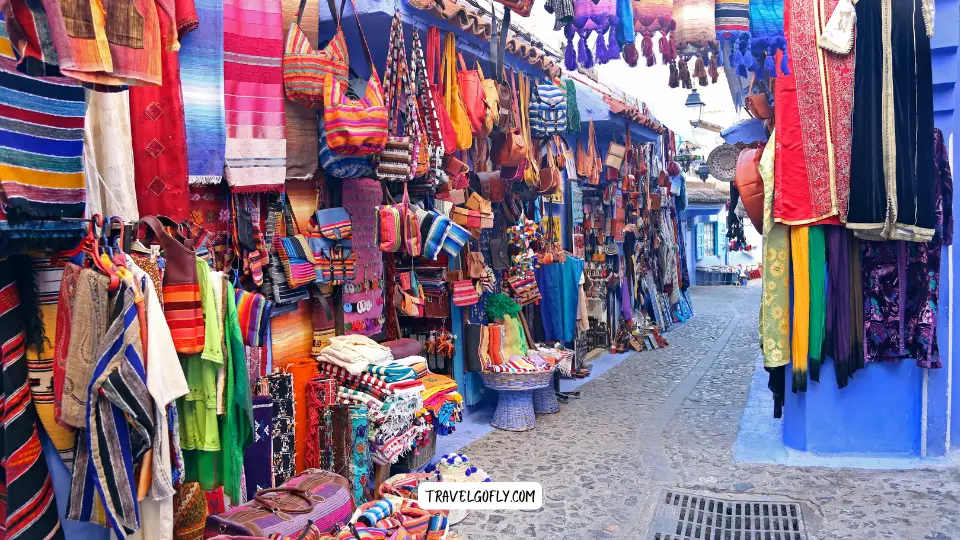 Shopping in the blue city of Morocco offers a more relaxed experience than the bustling souks of Marrakech or Fes. Chefchaouen markets blend authentic craftsmanship with a gentler approach to commerce, making it a favorite destination for thoughtful souvenir hunting.
Shopping in the blue city of Morocco offers a more relaxed experience than the bustling souks of Marrakech or Fes. Chefchaouen markets blend authentic craftsmanship with a gentler approach to commerce, making it a favorite destination for thoughtful souvenir hunting.
What to Buy in Chefchaouen
Handwoven Textiles
Chefchaouen is renowned throughout Morocco for its distinctive woven products. Local artisans create beautiful blankets, rugs, and scarves using traditional looms.
What Makes Them Special: Look for items with the distinctive diamond patterns unique to the Rif Mountain region. The wool typically comes from local sheep and is often dyed using natural ingredients.
Where to Find: The dedicated textile souk near Plaza el Makhzen showcases work from local weaving cooperatives. For the most authentic pieces, visit the Women’s Cooperative on Rue Barcelona.
Price Range: Small wool scarves start at 100-150 MAD ($10-15), while larger handwoven blankets range from 400-1200 MAD ($40-120) depending on size and complexity.
Leather Goods
Building on Morocco’s famous leather tradition, Chefchaouen’s artisans create distinctive bags, poufs, and shoes.
What Makes Them Special: Look for the unique blue-tinted leather items exclusive to the blue city of Morocco.
Where to Find: The small leather workshops along Rue Targui offer both traditional and contemporary designs.
Price Range: Leather slippers (babouches) 150-250 MAD ($15-25), handbags 300-600 MAD ($30-60), poufs 400-800 MAD ($40-80).
Local Pottery & Ceramics
Blue and white ceramics reflect the city’s color palette and Andalusian influence.
What Makes It Special: The blue and white pottery features distinctive geometric patterns that echo the city’s architectural elements.
Where to Find: Several ceramic shops cluster around Bab El-Ain gate.
Price Range: Small decorative plates 80-150 MAD ($8-15), tea sets 300-500 MAD ($30-50).
Natural Products
The Rif Mountains are rich in herbs, flowers, and natural resources used in traditional remedies and beauty products.
What Makes Them Special: Look for locally-produced argan oil, rose water, mountain honey, and herbal tea blends unique to the region.
Where to Find: The herbalist shops near Plaza Uta el-Hammam offer a wide selection of natural products. For honey and argan oil, the small farmer’s market near Bab El-Ain on weekday mornings offers fresh products direct from producers.
Price Range: Small bottles of essential oils 50-100 MAD ($5-10), argan oil 100-200 MAD ($10-20) depending on quality and quantity.
Wooden Crafts
Intricate woodworking traditions produce beautiful decorative items and practical household goods.
What Makes Them Special: Look for cedar wood items with inlaid patterns or carved with traditional Berber symbols.
Where to Find: Woodworking shops on Rue Hassan I showcase these traditional crafts.
Price Range: Small decorative boxes 100-200 MAD ($10-20), carved serving utensils 50-100 MAD ($5-10).
Where to Shop
The Medina Main Streets: Rue Suika and the streets immediately surrounding Plaza Uta el-Hammam offer the highest concentration of shops.
The Thursday Market: If your visit coincides with Thursday, don’t miss the weekly souk where villagers from surrounding areas bring their products to sell. Located just outside Bab El-Ain gate.
Artisan Cooperatives: For ethically-produced goods where more money goes directly to artisans, visit:
- The Women’s Weaving Cooperative (Rue Barcelona)
- Association Talassemtane (near Bab El-Ain)
- Cooperative Artisanale (Rue Hassan I)
Guide to Respectful Haggling
Haggling is expected in Chefchaouen, but the process tends to be more relaxed than in larger Moroccan cities. Here’s how to navigate it respectfully:
- Start at 40-50% of the initial asking price for most items (though less aggressive discounting for items in cooperatives where prices are often fairer to begin with).
- Maintain a friendly, respectful attitude throughout—haggling should be conversational rather than confrontational.
- Know when prices are fixed: items in cooperatives or those with tagged prices are often non-negotiable.
- Shop around before committing to understand the price range for items you’re interested in.
- Be willing to walk away if you can’t reach an agreeable price, but don’t begin negotiations unless you have genuine interest in the item.
- Consider fair value rather than getting the absolute lowest price—remember that artisans deserve fair compensation for their skilled work.
Local Insight: “When a shopkeeper offers you tea during negotiations, it’s not a sales tactic but an expression of hospitality,” explains Hassan, a local guide. “Accepting doesn’t obligate you to purchase, but shows respect for our customs.”
Shopping Etiquette Tips
- Photography: Always ask permission before photographing merchandise or artisans at work.
- Packaging: Bring a reusable bag for smaller purchases to reduce plastic waste in the blue city.
- Customs Regulations: Be aware that antiques over 100 years old cannot legally leave Morocco. For newer handcrafted items, keep receipts for potential customs questions.
With these insights, you can approach shopping in Chefchaouen as not just a transaction but a cultural exchange, bringing home meaningful souvenirs that truly represent the spirit and craftsmanship of this enchanting blue city of Morocco.
Responsible & Respectful Tourism in Chefchaouen
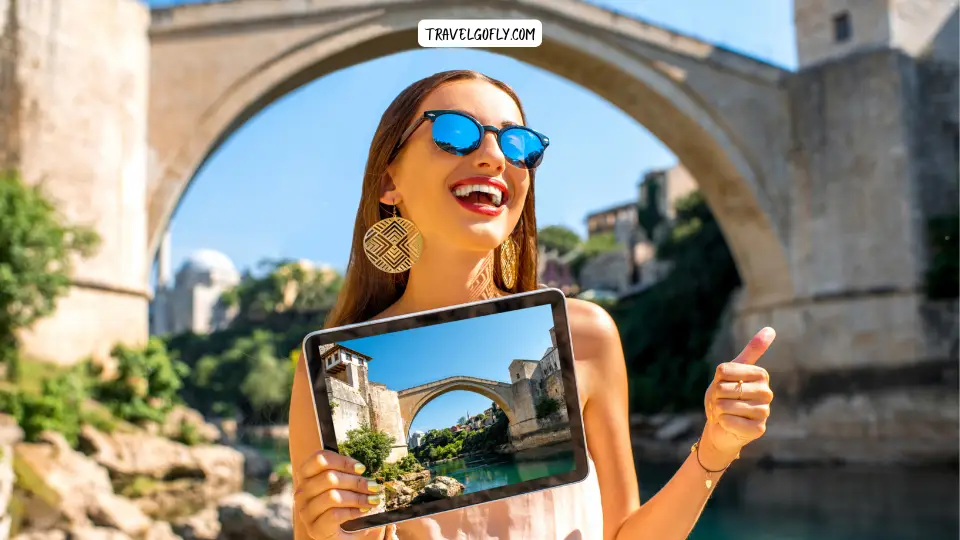 As Chefchaouen popularity grows, responsible tourism becomes increasingly important for preserving the authentic character and sustainability of this unique blue city of Morocco. By approaching your visit thoughtfully, you can ensure your presence contributes positively to both the local community and environment.
As Chefchaouen popularity grows, responsible tourism becomes increasingly important for preserving the authentic character and sustainability of this unique blue city of Morocco. By approaching your visit thoughtfully, you can ensure your presence contributes positively to both the local community and environment.
Cultural Sensitivities to Consider
Dress Code & Modesty
While Chefchaouen is more relaxed than some Moroccan cities, respectful attire is appreciated:
- Both men and women should cover shoulders and knees, especially when visiting religious sites or more traditional neighborhoods
- Loose-fitting, lightweight clothing is both culturally appropriate and practical for the climate
- Women might consider carrying a light scarf to cover their hair when entering areas near mosques
Local Perspective: “We welcome visitors from around the world,” says Fatima, who works at a local riad, “but we appreciate when they respect our traditions through their clothing choices. It shows mutual respect.”
Photography Etiquette
The photogenic blue streets make Chefchaouen a photographer’s paradise, but remember:
- Always ask permission before photographing local residents
- Offer a small tip (5-10 MAD) if taking posed portraits
- Be mindful about photographing children without parental consent
- Respect “no photography” signs, particularly at religious sites
- Be considerate about blocking narrow streets or doorways while taking photos
Religious Considerations
As a conservative Muslim community:
- Non-Muslims cannot enter mosques in Chefchaouen (with the exception of the abandoned Spanish Mosque viewpoint)
- Respect prayer times, particularly Friday afternoon prayers
- During Ramadan, avoid eating, drinking, or smoking in public during daylight hours
Supporting Local Communities
Economic Impact
Direct your tourism spending where it benefits locals:
- Stay in locally-owned accommodations rather than international chains
- Eat at family-run restaurants
- Purchase directly from artisans or cooperatives where possible
- Use local guides for excursions and tours
Did You Know?: Women’s cooperatives in Chefchaouen have revitalized traditional weaving techniques while providing economic independence for local women. Products purchased from these cooperatives directly support women’s financial empowerment.
Meaningful Interactions
- Learn a few basic Arabic or Darija phrases to connect with locals
- Show interest in traditional crafts and production methods
- Participate in cultural activities like cooking classes or craft workshops
- Engage with genuine curiosity rather than treating local life as a spectacle
Recommended Experience: Several local families offer traditional cooking workshops in their homes, providing authentic cultural exchange while supporting household incomes.
Minimizing Environmental Impact
Water Conservation
Water is precious in Morocco, particularly in mountain towns like Chefchaouen:
- Limit shower time and reuse towels when possible
- Consider the drought conditions when expecting certain amenities
- Support accommodations that implement water conservation measures
Waste Reduction
- Carry a reusable water bottle (safe drinking water refills are available at many accommodations)
- Decline plastic bags when shopping—bring a foldable cloth bag instead
- Dispose of trash properly, particularly when hiking in surrounding natural areas
- Consider carbon offset options for your flights to Morocco
Sustainable Transport
- Explore the compact medina on foot rather than using vehicles
- Use public transportation or shared taxis for longer distances when possible
- Consider group tours to natural areas rather than private transportation
Community Initiatives Worth Supporting
Association Rif Al Andalous: This non-profit organization works to preserve Chefchaouen’s cultural heritage while providing education for disadvantaged youth.
Talassemtane National Park Conservation Projects: Several initiatives focus on protecting the unique biodiversity of the surrounding mountains while providing sustainable livelihoods for local communities.
Plastic Free Chefchaouen: This grassroots movement works to reduce single-use plastics in the blue city through education and alternatives.
Finding Balance
Tourism has brought economic benefits to Chefchaouen, but also challenges. By approaching your visit with awareness and respect, you help maintain the delicate balance between sharing this beautiful blue city of Morocco with the world and preserving what makes it special.
“The true beauty of Chefchaouen isn’t just in its blue walls,” reflects Omar, a lifelong resident and local guide. “It’s in our way of life, our traditions, and our connection to these mountains. The most meaningful souvenirs visitors take home are the memories of authentic exchanges with our community.”
By practicing responsible tourism, you’ll not only have a more meaningful experience but help ensure that future generations can also experience the magic of the blue city of Morocco.
Sample Chefchaouen Itineraries (1, 2, and 3 Days)
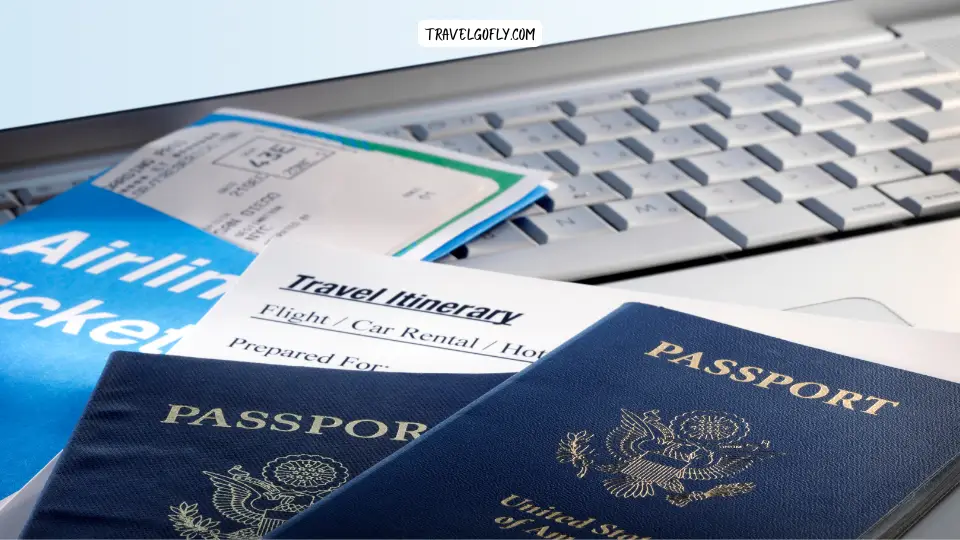 Whether you have just 24 hours or a leisurely three days to explore the blue city of Morocco, these carefully crafted itineraries will help you experience the best of Chefchaouen based on your available time.
Whether you have just 24 hours or a leisurely three days to explore the blue city of Morocco, these carefully crafted itineraries will help you experience the best of Chefchaouen based on your available time.
One-Day Itinerary: Chefchaouen Highlights
Perfect for those making a quick visit to the blue city of Morocco as part of a broader Moroccan journey.
Morning
- 7:00-8:30 AM: Early morning walk through the blue medina before crowds emerge. Focus on the northeastern section for the most photogenic blue streets.
- 8:30-9:30 AM: Enjoy a traditional Moroccan breakfast at your riad or at Café Clock.
- 9:30-11:00 AM: Visit the Kasbah Museum to learn about Chefchaouen’s history and climb the tower for panoramic views.
- 11:00 AM-12:30 PM: Explore Plaza Uta el-Hammam and browse shops along Rue Hassan I for unique crafts.
Afternoon
- 12:30-2:00 PM: Lunch at Restaurant Beldi Bab Ssour for authentic local cuisine.
- 2:00-4:00 PM: Continue exploring the medina, visiting the artisan cooperatives and watching craftspeople at work.
- 4:00-5:30 PM: Hike to the Spanish Mosque viewpoint for sunset views over the blue city.
- 5:30-7:00 PM: Return via Ras El Ma waterfall to see local women washing clothes and follow the stream path briefly uphill.
Evening
- 7:30-9:00 PM: Dinner at Café Aladdin overlooking the main plaza.
- 9:00-10:00 PM: Evening stroll through the medina to experience the blue city’s tranquil nighttime atmosphere.
Practical Tips for One Day:
- Store luggage at your transportation hub or arrange late checkout if staying one night
- Wear comfortable shoes as you’ll be walking on uneven surfaces all day
- Carry water and sun protection
- Have your camera ready throughout the day
Two-Day Itinerary: Deeper Blue City Exploration
This itinerary allows for a more relaxed pace and deeper cultural experiences in Chefchaouen.
Day 1 Morning
- 8:00-9:30 AM: Breakfast at your accommodation before a guided walking tour with a local guide (arrange through your riad, approximately 200 MAD for 2-3 hours).
- 9:30 AM-12:30 PM: With your guide, explore hidden corners of the medina, learning about local history, architecture, and daily life.
Afternoon
- 12:30-2:00 PM: Lunch at Sofia’s Snack for affordable local fare.
- 2:00-4:00 PM: Visit the Ethnographic Museum followed by shopping time at the Women’s Weaving Cooperative.
- 4:00-6:30 PM: Hike to the Spanish Mosque for sunset views, taking time to enjoy the scenery and photograph the blue city from different angles.
Evening
- 7:00-9:00 PM: Dinner at Lala Mesouda for traditional Moroccan cuisine.
- 9:00-10:00 PM: Mint tea at a café in Plaza Uta el-Hammam to observe local evening social life.
Day 2 Morning
- 8:00-9:00 AM: Early breakfast at your riad.
- 9:00-10:30 AM: Visit areas of the medina you haven’t yet explored, focusing on photography during the morning light.
- 10:30 AM-12:30 PM: Participate in a traditional cooking class to learn about local cuisine (arrange through your accommodation, approximately 250-350 MAD).
Afternoon
- 12:30-2:00 PM: Enjoy the meal you prepared during your cooking class.
- 2:00-3:30 PM: Relax with a traditional hammam experience (50-150 MAD depending on services).
- 3:30-6:00 PM: Walk to Ras El Ma waterfall and follow the path further uphill for a short nature experience away from the blue streets.
Evening
- 6:30-8:30 PM: Dinner at Café Restaurant Belmundo with mountain views.
- 8:30-10:00 PM: Shop for any final souvenirs or enjoy a relaxed evening at a rooftop café.
Three-Day Itinerary: Comprehensive Blue City & Natural Surroundings
This extended itinerary allows you to experience both the blue city of Morocco and its magnificent natural surroundings.
Day 1: Blue City Immersion Morning
- Similar to Day 1 of the two-day itinerary, focusing on orientation and the historic center.
Afternoon
- Expand your exploration to include the Jewish Quarter (Mellah) and eastern medina areas.
- Visit Plaza el Makhzen and its surrounding craft shops.
Evening
- Dinner at Restaurant Populaire Bab Ssour for authentic local dishes.
- Evening walk through illuminated streets.
Day 2: Mountain Adventure Morning
- 7:00-8:00 AM: Early breakfast at your accommodation.
- 8:00 AM: Depart for Akchour (arrange transport through your riad or at the taxi stand).
- 9:00 AM-3:00 PM: Hike to either God’s Bridge or the Grand Cascade, enjoying a riverside lunch at one of the small cafés.
Afternoon/Evening
- 3:30-5:00 PM: Return to Chefchaouen.
- 5:00-7:00 PM: Rest and refresh at your accommodation.
- 7:00-9:00 PM: Dinner at Restaurant Aladdin in the main plaza.
- 9:00-10:00 PM: Relaxed evening stroll or enjoy a cultural performance if available.
Day 3: Cultural Depth & Final Explorations Morning
- 8:30-9:30 AM: Breakfast at Café Clock.
- 9:30-11:00 AM: Attend a weaving or pottery workshop to learn traditional crafts (arrange in advance).
- 11:00 AM-1:00 PM: Visit any remaining corners of the medina you haven’t explored and shop for quality souvenirs.
Afternoon
- 1:00-2:30 PM: Lunch at Café Hafa near the waterfall.
- 2:30-4:30 PM: Visit the Kasbah Museum if you haven’t already, or explore the upper parts of the medina near Bab El-Ain.
- 4:30-6:30 PM: Return to your favorite viewpoint for final photographs of the blue city of Morocco.
Evening
- 7:00-9:00 PM: Farewell dinner at Lala Mesouda or another restaurant you’ve discovered during your stay.
- 9:00-10:00 PM: Final evening walk through the blue streets, perhaps purchasing some mint tea from a local vendor to enjoy on your riad’s terrace.
Extended Stay Options: If you have more time, consider day trips to:
- Talassemtane National Park for more extensive hiking
- Oued Laou for Mediterranean beaches
- Traditional Berber villages in the surrounding mountains
These itineraries provide flexible frameworks that you can adjust based on your interests, energy levels, and the season of your visit to the enchanting blue city of Morocco.
Chefchaouen Photography Guide: Capturing the Magic
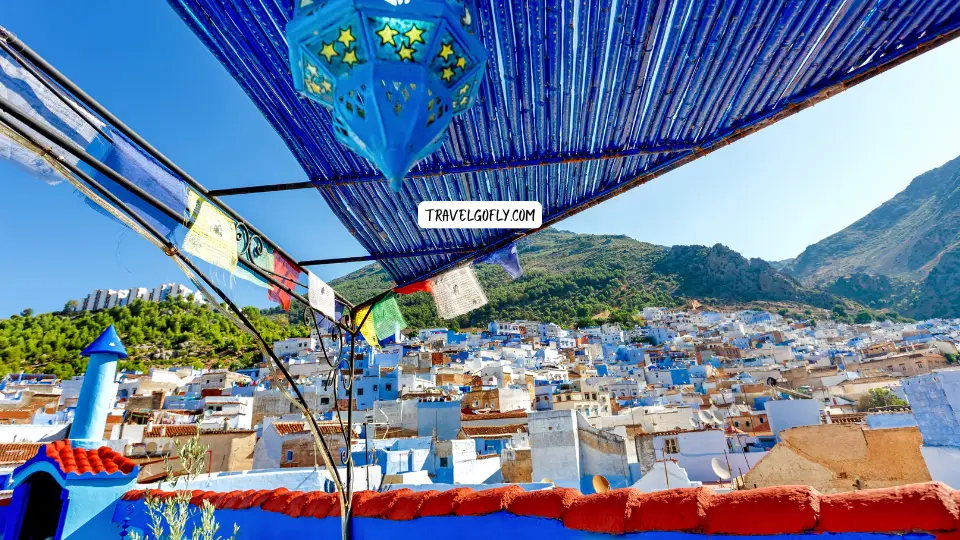 The blue city of Morocco presents endless photographic opportunities, from sweeping vistas to intimate architectural details. This guide will help both amateur and serious photographers capture Chefchaouen’s unique beauty.
The blue city of Morocco presents endless photographic opportunities, from sweeping vistas to intimate architectural details. This guide will help both amateur and serious photographers capture Chefchaouen’s unique beauty.
Optimal Photography Times
Golden Hour Magic (7:00-9:00 AM and 5:00-7:00 PM) The soft, warm light of early morning and late afternoon creates magical contrast with the blue tones. During these hours, the sun casts longer shadows that add depth and dimension to the narrow alleyways.
Blue Hour (30 minutes before sunrise and after sunset) This brief window bathes the already blue city in an ethereal blue light, creating a dreamlike ambiance perfect for atmospheric shots.
Midday Considerations While typically avoided by photographers for harsh shadows, the strong midday sun in Chefchaouen can actually work well in certain areas where it illuminates the vibrant blue pigments. Narrow streets with overhead coverings filter the light beautifully during these hours.
Location-Specific Tips
The Blue Stairs (near Hotel Parador)
- Best Time: Mid-morning when sunlight streams down the steps
- Composition Tip: Include the hanging plants and colorful pots for additional visual interest
- Challenge: This is one of the most photographed spots in the blue city—try unusual angles or include local life elements for unique perspectives
Plaza Uta el-Hammam
- Best Time: Early morning before crowds arrive or evening when locals gather
- Composition Tip: Use the Kasbah walls as a powerful backdrop
- Technical Tip: Wide-angle lens (16-24mm equivalent) to capture the entire plaza
Rooftop Views
- Best Time: Late afternoon as the sun begins to set
- Recommended Spots: Hotel Atlas rooftop, Lina Ryad terrace, Casa Perleta
- Composition Tip: Include both the blue medina and mountain backdrop for context
Spanish Mosque Viewpoint
- Best Time: 30-45 minutes before sunset
- Gear Tip: Bring a tripod for low-light conditions
- Composition Tip: Use the winding path leading to the city as a natural leading line
Narrow Blue Alleys
- Best Location: Northeast section of the medina
- Composition Tip: Look for contrasting elements—red flowerpots, yellow items, or locals in colorful clothing against the blue backdrop
- Technical Tip: Use a moderate aperture (f/8-f/11) for good depth of field in the narrow spaces
Equipment Recommendations
Lenses:
- Wide-angle (16-35mm): Essential for narrow streets and comprehensive architectural shots
- Standard zoom (24-70mm): Versatile for most situations
- Prime lens (35mm or 50mm): Excellent for street photography and low-light situations
Accessories:
- Polarizing filter: Helps manage reflections and enhances the blue tones
- Small tripod or stabilizer: For low-light situations, particularly during blue hour
- Lens hood: To manage flare when shooting toward the sun
- Extra batteries: Full days of shooting will drain power quickly
Smartphone Photography:
- Use HDR mode for high-contrast scenes
- Activate grid lines to help with composition
- For iPhone users, the .5x ultrawide lens works well in narrow streets
- Consider apps like Lightroom Mobile or Snapseed for on-the-go editing
Composition Strategies
Look for Frames Within Frames Doorways, windows, and archways create natural frames that add depth to your images of the blue city of Morocco.
Seek Out Color Contrasts While blue dominates, look for complementary colors:
- Yellow doors and accents pop dramatically against blue
- Terracotta roof tiles create pleasing contrast with blue walls
- Green plants and flowers add vibrant focal points
Include Human Elements Respectfully incorporating local residents or fellow travelers adds scale and storytelling dimensions to your images.
Explore Different Perspectives
- Get low to emphasize textured cobblestone streets
- Shoot from elevated positions to capture the maze-like quality of the medina
- Look up to document the variations in blue-painted buildings and sky
Detail Shots Beyond the broad street scenes, focus on telling details:
- Weathered blue doors with intricate knockers
- Patterns in tilework and stonework
- Traditional crafts being made
- Stacked goods in market displays
Respectful Photography Ethics
Always Ask Permission when photographing local people, especially in close-up portraits. A smile and gesture toward your camera is often understood across language barriers.
Respect Privacy by avoiding shots into homes through open doors or windows.
Be Aware of Religious Sensitivities around mosques and during prayer times.
Consider Fair Compensation when taking portraits offering a small payment (10-20 MAD) or purchasing items from vendors you photograph is appropriate.
Share Your Results when possible many locals appreciate seeing their digital image and might provide an email address to receive copies.
Post-Processing Tips
Color Balancing: The blues of Chefchaouen range from pale sky blue to deep indigo. Resist the urge to oversaturate the authentic colors are beautiful.
Contrast Management: The strong North African light creates high contrast. Consider using graduated filters or HDR techniques for balanced exposures.
Local Adjustments: Use selective editing to bring out details in shadowed doorways while maintaining highlight detail in sunlit areas.
By approaching photography in Chefchaouen with both technical knowledge and cultural sensitivity, you’ll return home with compelling images that capture the essence of this magical blue city of Morocco.
Frequently Asked Questions (FAQ) about Chefchaouen
Is Chefchaouen safe for solo female travelers?
Yes, Chefchaouen is generally considered safe for solo female travelers. The city has a relaxed atmosphere and friendly locals who are accustomed to tourists. However, as with any destination, it’s advisable to exercise standard precautions: avoid walking alone late at night, dress respectfully to honor local customs, and stay aware of your surroundings. Many solo female travelers report feeling comfortable and welcomed in Chefchaouen.
How many days do you need in Chefchaouen?
Most visitors find that 2-3 days is the ideal amount of time to experience Chefchaouen. This gives you enough time to explore the blue medina thoroughly, take day trips to nearby natural attractions like Akchour Waterfalls, enjoy the local cuisine, and soak in the relaxed atmosphere without rushing. If you’re on a tight schedule, you could see the highlights in a full day, but staying overnight allows you to experience the city magical morning and evening light.
Is Chefchaouen expensive?
Chefchaouen is relatively affordable compared to many European and North American destinations, though it can be slightly more expensive than other Moroccan cities due to its popularity with tourists. Budget travelers can get by on $30-50 per day, including accommodation in a modest riad or hostel, local meals, and some activities. Mid-range travelers might spend $60-100 daily for more comfortable accommodations and dining options. Costs vary significantly based on travel style, season, and how much shopping you plan to do.
Why is Chefchaouen blue?
There are several theories about why Chefchaouen’s buildings are painted blue. The most common explanations include:
- Jewish tradition: The blue was introduced by Jewish refugees who settled there in the 1930s, as blue represents the sky and heaven in Jewish tradition.
- Practical reasons: The blue color helps keep houses cool and repels mosquitoes.
- Water symbolism: Blue represents the Mediterranean Sea and the importance of water.
- Tourist appeal: The tradition has been maintained and expanded because of its uniqueness and appeal to visitors.
Regardless of the original reason, today the blue color is maintained because it has become the city’s identity and main attraction.
When is the best time to visit Chefchaouen?
The best time to visit Chefchaouen is during spring (April to May) and fall (September to October) when temperatures are mild and comfortable for exploring. Summer (June to August) can be quite hot, though cooler than many other Moroccan cities due to its mountain location. Winter (November to March) brings cooler temperatures and occasional rain, with January and February being the coldest months. However, winter visits offer fewer crowds and a more authentic experience, as long as you’re prepared for potentially cooler weather.
Can you drink alcohol in Chefchaouen?
As with most of Morocco, alcohol isn’t widely available in Chefchaouen due to Islamic traditions. Most local restaurants and cafes don’t serve alcohol. However, some higher-end hotels and restaurants catering to tourists may offer limited selections. If drinking alcohol is important to you, it’s best to check in advance with your accommodation about availability or bring your own from duty-free shops (respecting local customs by consuming it discreetly at your accommodation).
How do you get to Chefchaouen from major cities?
Getting to Chefchaouen requires some planning as there’s no train service directly to the city:
- From Tangier: The easiest route, with direct buses taking 2-3 hours.
- From Casablanca: Take a train to either Tangier or Fes, then connect by bus or shared taxi (grand taxi). The total journey takes 6-8 hours.
- From Fes: Direct buses take about 4 hours.
- From Marrakech: This is the longest route, typically requiring an overnight stop or a very long day of travel (10+ hours).
CTM and Supratours are reliable bus companies that service these routes. Alternatively, you can hire a private driver for more flexibility but at a higher cost.
Is Chefchaouen worth visiting?
Absolutely! Chefchaouen offers a unique experience that you won’t find elsewhere in Morocco or the world. Its distinctive blue-washed buildings create a dreamlike atmosphere, while its location in the Rif Mountains provides stunning natural scenery. The city offers a more relaxed pace than Morocco larger cities, authentic Moroccan culture with fewer tourist crowds (especially outside peak season), excellent shopping for handicrafts, and delicious local cuisine. Many travelers consider Chefchaouen a highlight of their Moroccan journey.
What should I wear in Chefchaouen?
While Chefchaouen is more relaxed than some other Moroccan cities, respectful dress is still appreciated:
- For women: Clothing that covers shoulders and knees is recommended. Lightweight, loose-fitting pants, long skirts, and tops with sleeves are ideal. A scarf is useful for additional coverage when needed.
- For men: T-shirts are fine, but shorts that reach the knee are more respectful than very short ones.
- For all travelers: Comfortable walking shoes are essential as you’ll navigate many steep, sometimes slippery cobblestone streets.
During summer months, light, breathable fabrics are best, while layers are recommended for cooler evening temperatures year-round and during winter visits.
Are there any day trips from Chefchaouen?
Yes, several worthwhile day trips from Chefchaouen include:
- Akchour Waterfalls: About 30 minutes from the city, offering beautiful hiking trails and swimming opportunities.
- Talassemtane National Park: Explore stunning mountain landscapes, diverse flora and fauna, and hiking trails.
- God Bridge: A natural rock arch over the river in the Akchour area.
- Cannabis fields: The surrounding Rif Mountains are known for cannabis cultivation (viewing only, as purchase and consumption remain illegal).
- Local Berber villages: Experience authentic rural Moroccan life in nearby villages.
For most of these excursions, hiring a local guide is recommended for the best experience and to support the local economy.
Is photography allowed in Chefchaouen?
Photography is generally welcome in Chefchaouen’s public spaces, and the photogenic blue streets are a photographer dream. However, follow these guidelines:
- Always ask permission before photographing local people, especially women and children.
- Some locals may request a small tip for photos.
- Avoid photographing inside shops unless you’ve asked permission or made a purchase.
- Be respectful when photographing in or near religious sites.
- Professional photographers planning commercial shoots should obtain proper permissions.
Morning and late afternoon offer the best light for capturing the blue hues of the city.
Conclusion
Chefchaouen isn’t just a destination; it’s an experience that captivates your senses and stays with you long after you’ve returned home. The enchanting blue alleyways that seem to lead into another dimension, the genuine warmth of local smiles, the serene backdrop of the Rif Mountains, and the rhythm of daily life unfolding in the medina these elements combine to create a place unlike any other in Morocco or indeed the world.
What makes Chefchaouen truly special is its ability to offer both tranquility and adventure. You can lose yourself in meditation while watching sunset paint the blue city in golden hues, challenge yourself on mountain trails with rewarding panoramic views, connect with local artisans whose hands create treasures with generations of skill, or simply savor the perfect mint tea moment as the call to prayer echoes across the valley.
Whether you’re a photographer chasing the perfect blue composition, a traveler seeking authentic cultural experiences, an adventurer eager to explore surrounding natural wonders, or someone simply needing a peaceful escape from the hustle of modern life, Chefchaouen offers a piece of itself that resonates with your particular journey.
As you plan your Moroccan adventure, remember that Chefchaouen isn’t just a checkbox on an itinerary—it’s a place that deserves time, attention, and openness to unexpected discoveries. The blue city doesn’t reveal all its secrets at once; it rewards those who slow down and allow themselves to be present.
Start planning your unforgettable journey to Chefchaouen now, and prepare to be embraced by the blue magic that has captivated travelers for generations. The memories you create among these azure walls will color your travel stories for years to come.
